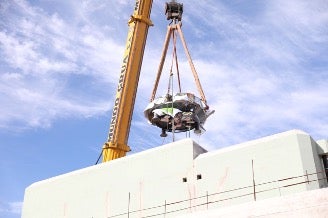
A cyclotron weighing 230 tonnes has been lifted in two stages El into the building of the Argentine Proton Therapy Centre (CeArP – Centro Argentino de Protonterapia) being built in Buenos Aires City. The CeArP is a joint project involving the National Atomic Energy Commission (CNEA – Comisión Nacional de Energía Atómica), Buenos Aires University (UBA – Universidad de Buenos Aires), private technology company INVAP (INVestigación APlicada – applied research) and Belgium’s IBA (Ion Beam Applications).
The operation was carried out by specialists from IBA, which supplied the cyclotron. After hooking the lower half to the crane with huge cables, its lifting was done slowly so that it could be placed in its exact position inside the bunker. A similar task was performed for the top half.
The C230 model cyclotron, from the Proteus Plus system, will be the heart of this centre. It is a circular particle accelerator that produces proton beams. It is located in an armoured enclosure with concrete walls up to four metres wide. Placing it into this bunker was a high precision operation.
The 8,000-square-metre CeArP is being built next to the Nuclear Diagnosis Centre Foundation (FCDN – Fundacion Centro Diagnostico Nuclear) and opposite the Ángel H Roffo Institute of Oncology, with which the CeArP will be closely related for the integral care and support of patients with cancer. It will be the first proton centre for cancer treatment in the Southern Hemisphere.
“This is a very important milestone, because the cyclotron is the main machine of the Argentine Centre for Protontherapy” said CNEA Vice President nuclear engineer Luis Rovere, who attended the cyclotron installation. “Gantries will be installed in the coming days, which are the structures through which proton beams are directed to the patients. We estimate that the first tests could start in the second half of 2025.”
Soon, two treatment rooms will install separate gantries each weighing 110 tonnes with a robotic chair that moves the person to the position necessary for treatment. Proton therapy is a type of radiation therapy with external beams of radiation. Proton bundles can be directed with millimetre precision and only release their maximum energy in the tumour. Side effects on healthy tissues are reduced. “That is why proton therapy is especially indicated to treat paediatric cancer or tumours that are difficult to access,” Rovere explained.
The proton beams generated by the cyclotron will be directed to a sector dedicated to research and development -the Laboratory for Research & Development in Proton Therapy (LAIDEP -Laboratorio de Investigación y Desarrollo en Protonterapia).
In addition to proton therapy, CeArP will offer high-energy x-ray radiation therapy or photons with a Versa HD linear accelerator. A linear accelerator for CyberKnife radiosurgery has also been installed. It has a robotic arm that moves in all directions and radiates while viewing the tumour through real-time radiographic images. The equipment of the centre has a magnetic resonator and a dual energy tomograph.






